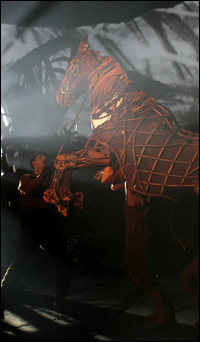
*
The National Theatre of Great Britain's acclaimed production of War Horse, winner of the 2011 Tony Award for Best Play, is one of those rare works that not only profoundly moves audiences, but fills them with a sense of wonder.
The goose bumps are provided by the Handspring Puppet Company, whose life-size horses are quite unlike anything ever seen before in a play. "To put an animal onstage as a real, thinking, feeling being that goes through a number of experiences is unique," says Handspring's Basil Jones. "We suspect it's quite historic. It's not something we set out to do; it's something we're noting in retrospect. But we've begun to think that staging the life of an animal over time in a theatrical context is actually quite unusual."
Based on the novel by Michael Morpurgo, the play follows the harrowing journey of a horse named Joey during World War I and the relentless effort of Albert, his former owner, to find him.
The recently launched U.S. tour can be seen this summer in Los Angeles and San Francisco. The production features 20 puppets: a goose, two crows, four swallows, four cavalry officers and nine horses, including, most unforgettably, Joey (as a foal and an adult) and his companion, Topthorn. Rotating teams of three puppeteers work Joey and Topthorn.
"There are 15 puppeteers in all, 12 for the two main characters," says Handspring's Adrian Kohler. "We rotate them because it's too physically demanding for one team to do eight shows a week."
The puppeteers, few of whom had any training in the art before being cast in the show, receive an immersive two-week education in puppetry and horses prior to the start of rehearsals. "They learn Handspring's philosophy and the basics of the mechanics of all aspects of the horse," says Jones.
 |
||
| "Joey" |
||
| photo by Paul Kolnik |
"There are two breathing slots which allow an up-and-down breath for the horse for as much as six inches or as little as a quarter of an inch," says Jones. "The amplitude of the breath is really important."
The third puppeteer, who is external, controls the horse's neck and head. Despite the visibility of the puppeteers (there is no attempt to hide their legs underneath the horse), the animals' movements are so authentic that audiences accept these creatures — made of cane, aluminum, leather and mesh — as living beings. "The ears and tail are very important," says Kohler, "because they show a range of emotions."
Jones adds, "We make the puppeteers very conscious of the use of micro movements as a way of indicating emotion and thought."
Jones and Kohler had not directed the puppets since the original production at the National Theatre. But they returned to work on the tour, which has been restaged to accommodate not only proscenium theatres, but the lack of a revolving floor. "The puppeteers' legs are now the revolving mechanism," says Jones. "They can move the legs of the horse in a galloping motion forward, but the puppeteers themselves can be moving in any direction. So every puppet has its own built-in revolve. I think we've got more interesting movement onstage in the touring production than we've had."
Kohler adds, "We discovered that we can achieve much more complicated movements for the horses without the revolve. We've actually found solutions that are thrilling."










